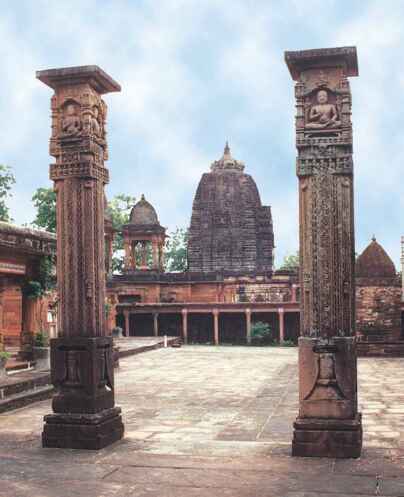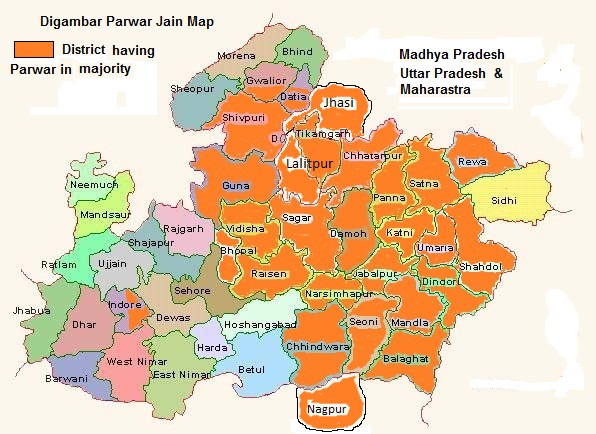Parwar (Jain) on:
[Wikipedia]
[Google]
[Amazon]
 Parwar, also spelt as Paravāra (परवार in Hindi, पौरपट्ट in Sanskrit inscriptions), is a major
Parwar, also spelt as Paravāra (परवार in Hindi, पौरपट्ट in Sanskrit inscriptions), is a major 
Map
along the Betwa river in early 20th century. The main concentration of the Parwars is still in these towns; however, many of them have moved to major industrial cities further away such as Delhi, Mumbai and Bangalore. A few Parwar families now migrated to America.
 Parwar, also spelt as Paravāra (परवार in Hindi, पौरपट्ट in Sanskrit inscriptions), is a major
Parwar, also spelt as Paravāra (परवार in Hindi, पौरपट्ट in Sanskrit inscriptions), is a major Jain
Jainism ( ), also known as Jain Dharma, is an Indian religion. Jainism traces its spiritual ideas and history through the succession of twenty-four tirthankaras (supreme preachers of ''Dharma''), with the first in the current time cycle being ...
community from the Bundelkhand region
Bundelkhand (, ) is a geographical and cultural region and a proposed state and also a mountain range in central & North India. The hilly region is now divided between the states of Uttar Pradesh and Madhya Pradesh, with the larger portion ly ...
, which is largely in Madhya Pradesh
Madhya Pradesh (, ; meaning 'central province') is a state in central India. Its capital city, capital is Bhopal, and the largest city is Indore, with Jabalpur, Ujjain, Gwalior, Sagar, Madhya Pradesh, Sagar, and Rewa, India, Rewa being the othe ...
, but also includes the two districts of Lalitpur and Jhansi
Jhansi (; Hindi: झांसी, Urdu: ) is a historic city in the Indian state of Uttar Pradesh. It lies in the region of Bundelkhand on the banks of the Pahuj River, in the extreme south of Uttar Pradesh. Jhansi is the administrative ...
in Uttar Pradesh. Apart from them, Nagpur district (Maharashtra) have also a very large Parwar community. There is an area in Itwari of Nagpur known as Parwar-Pura having large number of Parwar's homes and shops . Most of the Nagpur's Parwar are migrated from Sagar, Deori, and other small villages of Sagar District of MP. Parwar exclusively follow the Digambar Jain tradition. Parwar usually preferred their marriage within community. There are 12 Gotra in Parwar community. Each Gotra has 12 Moor (lineages). A marriage within the same gotra or lineage are not allowed. Traditionally a marriage within any of the 8 branches (the moor of boy or girl, mother's family, father's mother's family etc) was not permitted and hence the community was termed ''ashta-shakha''.
A number of Jain scholars have belonged to this community, including Tarana Swami, the founder of Taran Panth and the Bhattaraka
A Bhaṭṭāraka ( pka, भट्टारक "holy one") heads traditional Digambara Jain institutions. He is responsible for training scholars, maintenance of libraries, managing endowments, presiding over installation ceremonies and running ...
s of Chanderi. Osho was born in the Samaiya section of this community. Also, Pandit Sumerchand Diwakar, Pandit Nathuram Premi, Dr Hiralal Jain, Dr Mahendrakumar Nyayacarya, Pandit Phulacandra Shastri, Pandit Hiralal Jain, Pandit Balacandra Shastri, Pandit Jaganmohanlal Shastri, Pandit Devakinandan Nayak, Swami Satyabhakta, Wardha, philosopher, founder of Satya Samaj (1899–1998) many other illustrious scholars of Jainism were born in the Parwar (also spelt as Paravara) community. The map of districts having large number of Parwar Jains in Madhya Pradesh and Uttar Pradesh is shown below.

History
A number of inscriptions mentiong the community have been found in the region adjacent to the Betwa river, which flows on the border of MP and UP. In the older inscriptions they are called Paurapatta or Puravada. The oldest inscriptions include those found at Vidisha (948 CE), Pachrai (1065 CE), Aharji (1152, 1153), Chanderi (VS 1252,13450),Sironj
Sironj is a town and a municipality in Vidisha district in the Indian state of Madhya Pradesh.
Demographics
India census, Sironj had a population of 52,100. Males constitute 53% of the population and females 47%. Sironj has an average ...
(VS 1299, 1316), Narwar (VS 1319). A long inscription at Deogarh of VS 1493 mentions Lakshaman Singhai and his large family, who installed an idol of Lord Shantinath under the supervision of Bhattaraka
A Bhaṭṭāraka ( pka, भट्टारक "holy one") heads traditional Digambara Jain institutions. He is responsible for training scholars, maintenance of libraries, managing endowments, presiding over installation ceremonies and running ...
Devendrakirti of Balatkara Gana. It is probably the first mention of the Singhai (or Sanghapati) title in the region.
Some authors have proposed a historic connection between the Parwar and the Porwad communities.
Jainism had a continuous presence in this region since antiquity. Jainism was flourishing during the Gupta
Gupta () is a common surname or last name of Indian origin. It is based on the Sanskrit word गोप्तृ ''goptṛ'', which means 'guardian' or 'protector'. According to historian R. C. Majumdar, the surname ''Gupta'' was adopted by se ...
period at Vidisha region. The Durjanpur idols installed during the rule of Ramagupta date to about 365 AD. The Udaigiri cave Parshvanath
''Parshvanatha'' (), also known as ''Parshva'' () and ''Parasnath'', was the 23rd of 24 '' Tirthankaras'' (supreme preacher of dharma) of Jainism. He is the only Tirthankara who gained the title of ''Kalīkālkalpataru ( Kalpavriksha in this " ...
inscription mentioning the lineage of Bhadranvaya is dated to 425 AD. The great Shantinath temple at Deogarh was built before 862 CE, suggesting a prosperous Jain community in this region.
According to Mahavamsa, Devi, the wife of Maurya ruler Ashoka
Ashoka (, ; also ''Asoka''; 304 – 232 BCE), popularly known as Ashoka the Great, was the third emperor of the Maurya Empire of Indian subcontinent during to 232 BCE. His empire covered a large part of the Indian subcontinent, ...
was a daughter of a merchant of Vidisha, whose son Mahinda took Buddhism to Sri Lanka. It is likely that the Parwar community is a continuation of the ancient merchant community of the region.
Organization
The Parwars are divided into 12gotra
In Hindu culture, the term gotra (Sanskrit: गोत्र) is considered to be equivalent to lineage. It broadly refers to people who are descendants in an unbroken male line from a common male ancestor or patriline. Generally, the gotra ...
s, each gotra is further divided into 12 shakhas (mura)s. Traditionally 4 of the shakhas of the grandparents of the boy, and four of the shakhas of the grandparents of the girl were required to be distinct for a marriage to take place. Thus the Parwars were sometimes termed ashta-shaha.
There were once several social divisions among the Parwars, which are no longer significant.
Some Parwars follow Taran Panth and are called Samaiya, because Taran Swami based his teachings on Samayasara of Acharya Kundakunda.
Parwar Sabha was founded in 1917 at Ramtek, after the Bundelkhandiya Jain Sabha broke into community groups. In the 1924 convention, it was proposed that only four shakhas be considered for marriage, but the proposal was defeated. A newsletter Parwar Bandhu was published during 1929–1944.
A "Parwar Directory" was published in 1924 which included population data, according to which the Parwar population then was 48,074.Parwar Directory, Pannalal Jain Sivni, 1924 The community resided in 1438 towns and villages with largest population in Sagar, Jhansi
Jhansi (; Hindi: झांसी, Urdu: ) is a historic city in the Indian state of Uttar Pradesh. It lies in the region of Bundelkhand on the banks of the Pahuj River, in the extreme south of Uttar Pradesh. Jhansi is the administrative ...
, Jabalpur
Jabalpur is a city situated on the banks of Narmada River in the state of Madhya Pradesh, India. According to the 2011 census, it is the third-largest urban agglomeration in Madhya Pradesh and the country's 38th-largest urban agglomeration. J ...
, Damoh and Tikamgarh districts. The largest number are in Lalitpur (1122 in 1924), Mungawali (481), Khaniadhana (320), Pachhar (Ashoknagar Isagarh), Mandawara (304), Sivni (358), Sagar (595), Bamora (374), Khurai (503), Bina-Itawa (358), Pindarai (Mandla 314), Jabalpur (1058) and Tikamgarh. This puts the majority of the major centers within a 50-mile radius from Deogarh (sealong the Betwa river in early 20th century. The main concentration of the Parwars is still in these towns; however, many of them have moved to major industrial cities further away such as Delhi, Mumbai and Bangalore. A few Parwar families now migrated to America.
Distinguished Paravāra Jains
*Bhattaraka
A Bhaṭṭāraka ( pka, भट्टारक "holy one") heads traditional Digambara Jain institutions. He is responsible for training scholars, maintenance of libraries, managing endowments, presiding over installation ceremonies and running ...
Devendrakirti, founder of Chanderi and Gandhar/Rander seat.
* Nathuram Premi, Pandit Nathuram Premi, Historian, publisher and editor (26 November 1881 – 30 January 1960)
* Osho Rajneesh (1931–1990), Indian godman, mystic and founder of the Rajneesh movement
* Pandit Balachandra Shastri, Traditional Jain Scholar, best remembered for his work on the ''Satkhandāgama'' and the ''Kasāyapāhuda''
* Swami Satyabhakta, Wardha, philosopher, founder of Satya Samaj (1899–1998)
* Singhai Lakshmana, who installed Lord Shantinatha at Deogarh in 1436.
See also
* Chanderi * Balatkara Gana * Jainism in Bundelkhand * Golalare *Golapurva
Golapurva is an ancient Jain community from the Bundelkhand region of Madhya Pradesh.
History
Jainism had a continuous presence in the Bundelkhand region since antiquity. Jainism was flourishing during the Gupta period at Vidisha region. The D ...
* Gahoi
Gahoi is a merchant Vaishya-Baniya community in central India.
Gahois are divided into 12 gotras, each gotra is divided into six ''all''s. They have traditionally interdined with the Parwar Jain community of Bundelkhand.
The "Grahapati" family ...
References
{{reflist Social groups of Madhya Pradesh Jain communities Social groups of Uttar Pradesh Bundelkhand Jainism in Uttar Pradesh